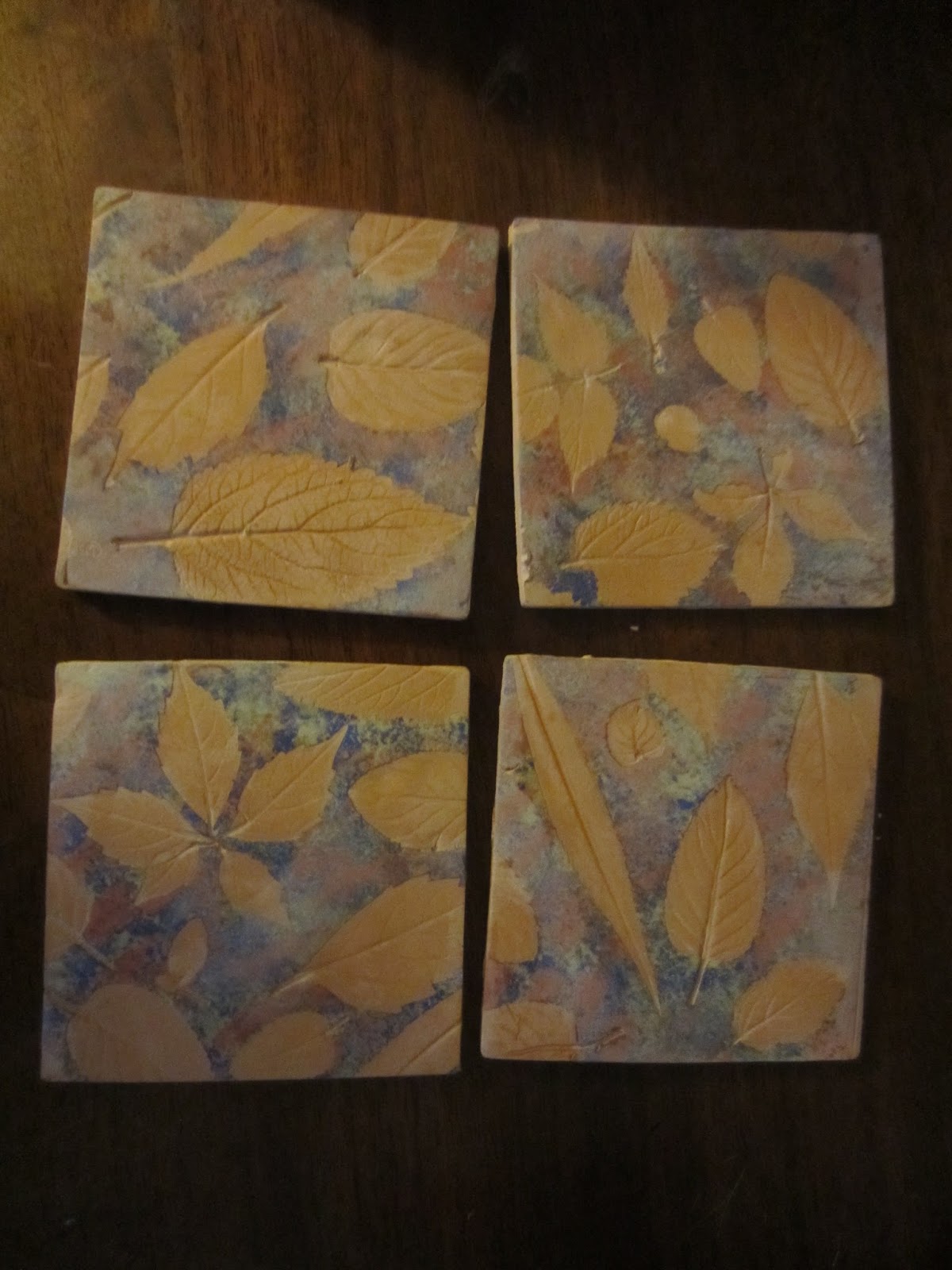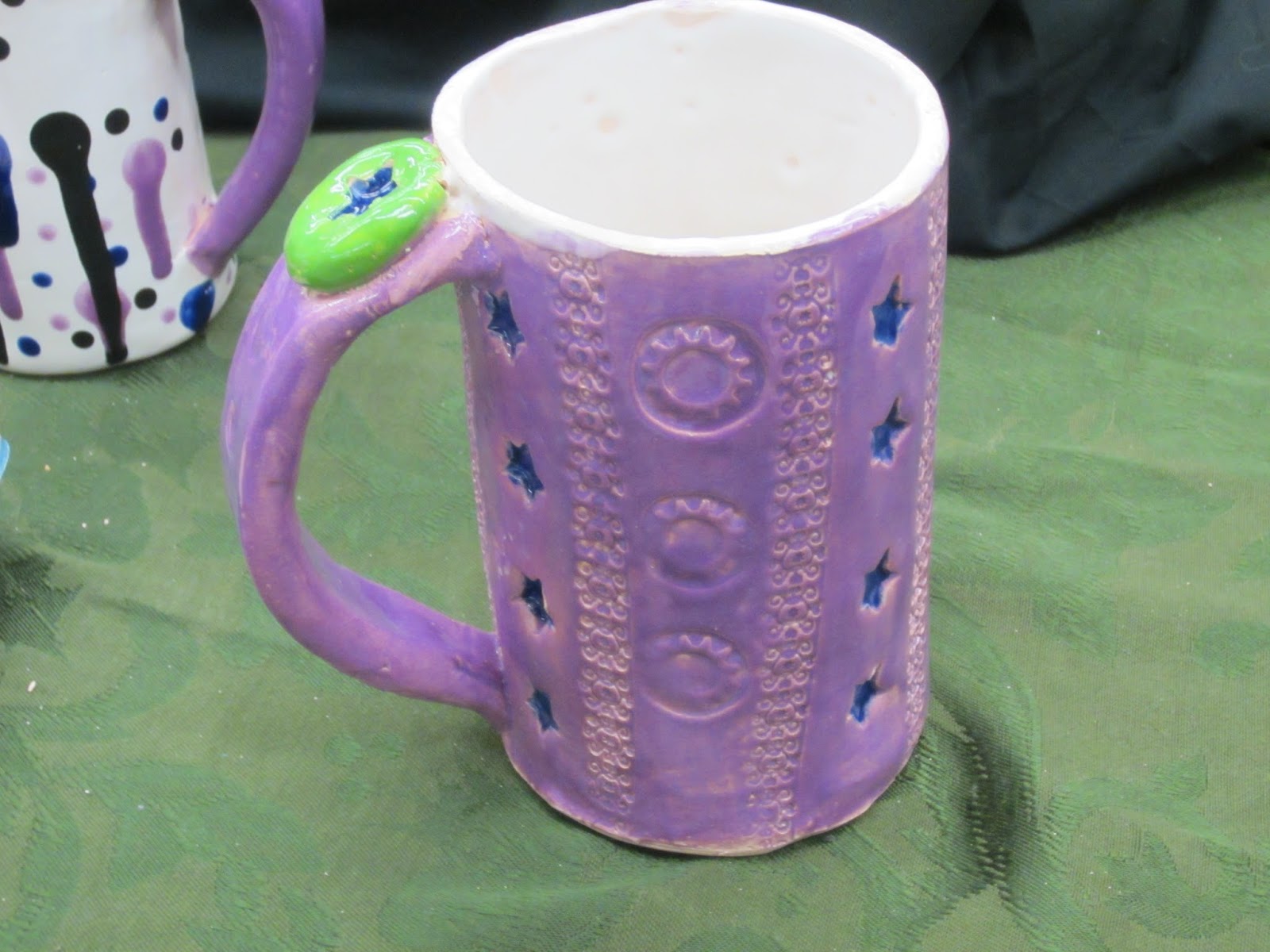Once again, aTi was a phenomenal experience. I simultaneously received enjoyment and frustration from breaking out of my "comfort zone;" excitement definitely won out though.
Deborah's course made me realize how many of today's consumers need to have appreciation for the process of artistic creation. It's very easy to go to big retailer and buy dishes, pots, mugs, and other clayware. However, when you buy things that way, you have the same pieces as thousands of others (makes me think of the houses in Edward Scissorhands) and, more importantly, you have a piece that was generated through mass production. "All Things Clay" made me more appreciative of the entire process of clay creation.
Although I consider myself to be a patient person, using the potter's wheel truly tested my patience. It was frustrating to go through the steps of mounding the clay, patting the clay, creating the bottom of the mug/dish/bowl, elongating the piece,...and then have the piece completely crumble. This was a valuable experience though. As adults, we often gravitate toward activities in which we know we will be skilled. Who would willingly try something at which she would struggle and/or possibly fail? I would say that, ultimately, I failed at the potter's wheel. However, whereas I normally (adult me) give up easily, I do feel compelled to try the wheel again in the future.
In terms of next year's aTi sessions (I'm already thinking ahead), I'm not sure what path I will take. Poetry, the familiar path, is one option. I would also gladly try "All Things Clay" again to see how much I could improve my skills. Songwriting fascinates me, but I literally have no singing skills. Digital photography also interests me. Foolishly, my mind thinks All you have to do is press your camera's silver button and be done with it. I know that photography is much more complicated than that.
Who knows what next year will bring, but I am grateful that I had the opportunity to participate in aTi 2013 at William Paterson University.
Although he is often the bearer of humor rather than wise words, I thought that the following Jerry Seinfeld quote was representative of my aTi experience:
"You have to motivate yourself with challenges. That's how you know you're still alive."
This blog details my experiences at the 2013 aTi North workshop, "All Things Clay." My instructor was Deborah Goletz.
Friday, August 9, 2013
Sunday, August 4, 2013
Day five: Afternoon presentations
After lunch (and giving into the fifth consecutive day of Panera cookie consumption), the final aTi presentations began. Each class was given about 20-30 minutes to showcase the work they completed within the week. Much like last year, it was remarkable to see the progress that people made over the course of five days.
The oil painting class had an array of work which they displayed. Some pieces were clearly done by "seasoned" artists (Chris' portrait was phenomenal-- the subject's eyes were mesmerizing), but the pieces done by less experience artists were also beautiful too. The thing that I like about aTi is how the program is so welcoming to teachers of all different levels and disciplines. I spoke to one woman who had never done oil painting in her life. With the guidance of teacher Kit Sailor, this woman was able to create lovely, proportionate paintings; most of her paintings featured lemons and I absolutely loved them!
The songwriting class fascinated me, most likely because songwriting elements (similes, metaphors, symbolism, repetition, rhyme) also appear in my coursework. There was variety in terms of the songs that participants composed. One student created a song with Miles Davis' music in the background; it reminded me of spoken word poetry. Another student created a happy children's song about summer. Another participant wrote a haunting song with the chorus: "Fireflies in your eyes..."
The students in Printmaking and Book Arts produced equally impressive pieces. Nowadays, we buy so many items that are mass-produced; people forget about the work that goes into something as seemingly "simple" as a notebook or journal. Likewise, in our All Things Clay class, Deborah spoke about mass productive versus handcrafted, individual pieces.
When aTi participants came into our classroom, we each demonstrated a task for viewers. I demonstrated how to roll out a slab and flatten it on the slab board. It's a task that seems easy enough, but when you actually try it (like most other activities in life), it is harder than it originally seemed.
Posted below are some of the photos from our All Things Clay showcase. We arranged all of our pieces by color, instead of arranging our pieces at individual tables. I liked that we displayed all of our pieces together because it further evoked the feel of us working together as a class.
Below are photos from our All Things Clay showcase. Photos 1-4 were taken by Jenifer Simon; the rest were taken by me.
The oil painting class had an array of work which they displayed. Some pieces were clearly done by "seasoned" artists (Chris' portrait was phenomenal-- the subject's eyes were mesmerizing), but the pieces done by less experience artists were also beautiful too. The thing that I like about aTi is how the program is so welcoming to teachers of all different levels and disciplines. I spoke to one woman who had never done oil painting in her life. With the guidance of teacher Kit Sailor, this woman was able to create lovely, proportionate paintings; most of her paintings featured lemons and I absolutely loved them!
The songwriting class fascinated me, most likely because songwriting elements (similes, metaphors, symbolism, repetition, rhyme) also appear in my coursework. There was variety in terms of the songs that participants composed. One student created a song with Miles Davis' music in the background; it reminded me of spoken word poetry. Another student created a happy children's song about summer. Another participant wrote a haunting song with the chorus: "Fireflies in your eyes..."
The students in Printmaking and Book Arts produced equally impressive pieces. Nowadays, we buy so many items that are mass-produced; people forget about the work that goes into something as seemingly "simple" as a notebook or journal. Likewise, in our All Things Clay class, Deborah spoke about mass productive versus handcrafted, individual pieces.
When aTi participants came into our classroom, we each demonstrated a task for viewers. I demonstrated how to roll out a slab and flatten it on the slab board. It's a task that seems easy enough, but when you actually try it (like most other activities in life), it is harder than it originally seemed.
Posted below are some of the photos from our All Things Clay showcase. We arranged all of our pieces by color, instead of arranging our pieces at individual tables. I liked that we displayed all of our pieces together because it further evoked the feel of us working together as a class.
Below are photos from our All Things Clay showcase. Photos 1-4 were taken by Jenifer Simon; the rest were taken by me.
 |
| These are some students' bisque pieces. I love the detail that some of the pieces have. |
 |
| "They like us. They really like us!" |
 |
| These are my tiles with the butcher's wax applied and then removed. |
 |
| These are some of our other final pieces (most of them are Raku pieces). |
 |
| This is Tracey's piece. She did not have the chance to use glazes on it, but instead used pastels and a black paint for the indentations. It's lovely! |
Raku video
Somewhere out there is a video of our group completing the Raku process. For now, this video from Youtube will have to suffice. This video will give people an idea of the Raku process from start to finish.
http://quietube6.com/v.php/http://www.youtube.com/watch?v=XaZbSHj23mo
http://quietube6.com/v.php/http://www.youtube.com/watch?v=XaZbSHj23mo
Day Five-- Raku
We spent most of the morning completing the Raku process. For our Raku pieces, we used a special glaze on day four. For Raku, pieces are removed from the kiln while they are basically glowing from the intensity of the temperatures. The piece is then put onto a "nest" of flammable material (in our case, we used newspaper shavings and wood shavings) and quickly covered. The result is a mixture of color and various "crackles" within the piece. Any parts of the piece that are not glazed will turn black during the Raku process.
When taking pieces out of the kiln during the Raku process, pieces can be as hot as 2100 degrees Fahrenheit. We all had to wear protective goggles and gloves. Deborah and two brave volunteers from our group, Sarah and Christine, also wore "leathers" to protect their bodies. Their task was to use tongs and take the pieces out of the kiln.
Once the pieces started coming out of the kiln, the process was exciting and scary. Some of the more oddly shaped pieces were especially difficult to handle with the tongs. I give Sarah, Jennifer, and Meghan so much credit for volunteering to take the pieces out of the kiln. Being that I am accident-prone (case in point: I once deeply cut my hand by trying to open a coffee can), I did not volunteer to take the pieces out of the kiln.
Below are photos of the Raku process. Please note: photos 1-8 were taken by Jenifer Simon. She's a stealthy photographer; she took so many pictures during aTi, but I didn't even realize she took them until they were posted online!
 |
| Our "nests" are ready... |
 |
| Our pieces "glowing;" this kiln has a crank-style function on the side so that you can open it during the firing process... |
 |
| Deborah, our fearless leader, taking some of the pieces out of the kiln. Notice how they colors have changed, as the glazes start showing. |
 |
| Some of us made "nests" in trash cans instead of in the sandbox. |
 |
| Deborah putting Karen's piece down onto the nest. I am next in life after Karen, but you can't really see me. The Raku process both amazed and terrified me. I stood still for most of the time :) |
 |
| Once the piece begins to smoke and fire, you cover it. The more time you take to cover it, the less variety of "crackles" and abstractness you will get. |
 |
| This is another piece from someone in my class. Its color is due to the choice of glaze. The Raku process creates the crackles and abstractions (hard to see in this pic). |
 |
| This is a side view of my fish. |
 |
| This is the bottom of the fish. The coppery tone tells you that the bottom of this piece had flames hitting it for longer than other portions of the piece. |
Subscribe to:
Comments (Atom)






